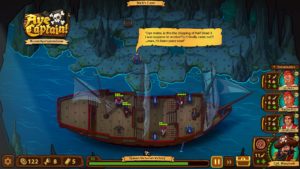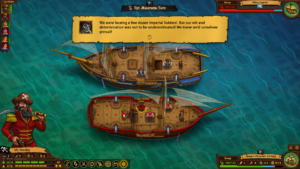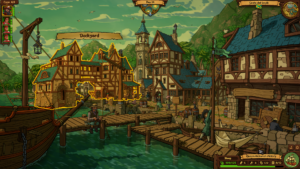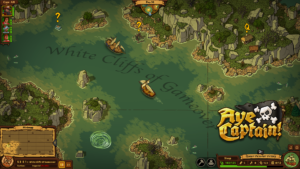I’m sure everyone knows what humour generally is, and can crack a joke or two themselves. Many of us try to put as many jokes, easter eggs and funny stuff in our games as we can, often without much consideration. In the end, most games supposed to be fun, right?
However, can we apply humour in more areas of our game design than just dialogues or animations?
Well… I’ll try to explore that idea a bit, with some examples from agame we are currently working on – “Aye Captain” – an FTL inspired Pirate RPG game.
Some Science first…

…by Science i mean, lets type in “humour” in Google browser.
According to Wikipedia, humour “is the tendency of experiences to provoke laughter and provide amusement. People of all ages and cultures respond to humour. Though ultimately decided by personal taste, the extent to which a person finds something humorous depends on a host of variables, including geographical location, culture, maturity, level of education, intelligence and context. For example, young children may favour slapstick such as Punch and Judy puppet shows or the Tom and Jerry cartoons, whose physical nature makes it accessible to them. By contrast, more sophisticated forms of humour such as satire require an understanding of its social meaning and context, and thus tend to appeal to a more mature audience.”
Thus, it is important to consider the target audience of our game before we decide what type of humour to use and where. I’m sure six year old Timmy won’t fully appreciate our sarcastic social commentary, and your grandma won’t laugh so hard seeing someone sliding on a banana peel.
In Aye Captain the target audience is not necessarily defined by age, but rather by interests. We assume that people who will play our game are at least a bit interested in the topic of history or sailing, and will already have a bit of knowledge and expectations in this field. Maybe we can base our jokes on that? But how?
So, now that we know how humour works, we can explore the ways in which we can use it in our games. Let’s start with dialogues, since it is the most obvious example, and seems to have an easy solution. Just write as many jokes as you can, right? Not really…
Funny Narrative

“Oye mates, is this the shipping of Half Dead 3 I was supposed to receive? Is it finally came out? …man, it’s been years now!”
Context
Stand-up comedians often create context in the beginning stage of their performance. The context itself is not necessarily funny, but it creates a platform for the audience, so that everyone can be on the same page. It makes it easier for the public to “get” the joke, and allows the comedian to “punch hard” without worrying that the joke will not be understood properly or feel out of place.
In Games, the artstyle, setting or genre creates context for the player, so that the designer can use it for his advantage in many ways. If our game features Pirates, players can safely assume there will be sea battles, plunder, tropical islands and all the other tropes of the genre. We can then make even a vague reference to a famous figure, place or event, and safely assume it will be familiar to the player. When we have context, we don’t have to explain everything and instead, focus more on situational jokes or even divert expectation in a comedic way.
Dialogues
Still, first and foremost, when writing dialogues in our games, we must consider things such as information we want to give the player at any given time. The number of words and overall flow of dialogue are rather important. We don’t want to sacrifice readability for the sake of a joke, or make the text too long, discouraging the player from reading the whole thing. Simultaneously we would like to avoid basing our jokes on non-universal references, such as current trends, famous people or pop culture that may not be relevant in the future. Little Timmy may not fully appreciate you putting Nikolai Tesla in your game, on the other hand your grandma probably won’t get your Lady Gaga reference.
In my opinion, the best case of a written dialogue with humour is a short text, that is clear and informative to the player, a joke of itself at the same time. It is important that everyone knows what they just read, and what it means in the context of a game, even if they did not get the joke at all. We may also refrain from making any jokes at all, for example when we want to create a feeling of horror or high stakes. Games can provide a wide array of emotions and it is wise to knowingly use each of them.
Narrative
The topic is broad and there are many different ways you can approach narrative systems in games and add humor to them. We went with the “unreliable narrator” trick. A pirate skeleton who’s telling the story of his “epic” adventures as the player goes through the game. He can make funny comments on the players actions or even lie straight in your face, exaggerating his accomplishments. If the player sees the lie right away, he may find that funny. We must be careful thou, as misplaced or misunderstood lie or a joke in the narrative can confuse the player, instead of being informative.

“We were facing a few dozen Imperial soldiers! But our wit and determination was not to be underestimated! We knew we’d somehow prevail!”
Humoristic Gameplay
Now, how can we add humour to our gameplay without sacrificing player agency and immersion?
I’m sure we’ve all had awesomely ridiculous ideas for hilarious game mechanics, that came up during an integrational party or at the point in a brainstorm meeting when everyone is tired. Nonetheless, I guess most of them did not make it into a game, because they would be most likely misunderstood.
You need to make a game at least a bit intuitional, so that the player will understand the overall concept without much explanation. You can approach this topic by putting small things here and there. Things that won’t break your game, like using fairly known abilities or actions and putting a twist on them. Maybe your “Confuse” status skill, instead of making a character do random actions, turns it into a chicken or a doll? Maybe your character can gain experience point by visiting a “Room upstairs” in the Tavern. Or maybe you can use your Loyalty mechanics to create some surprising situations on board your ship, that can lead to a mutiny. It can work if you commit to it and make it clear and enjoyable in minute to minute gameplay.
You can base your whole gameplay around some funny concept like jumping and breaking rocks with your head, eating mushrooms and climbing through pipes. Ultimately thou, “fun” gameplay is not necessarily a “humoristic” one. If your game has many other comical ingredients in it, then maybe you don’t have to make all the player actions hilarious as well and just leave them nice and clear.

Comedic Art Style
We can all agree that cartoon style works fine with comedy. We’ve all seen Looney tunes or Hanna- Barbera, and we expect humour from all things stylized and cartoony.
The art style of the game is the main determinant of tone and context we give to the player. He will assume at first glance if it has more light or dark tone, if it takes itself seriously or not and he will expect those same aspects in other parts of your game. Little Timmy seeing a poster of Bloodborne won’t imagine the game world to be cheerful, filled with characters cracking jokes and doing silly stuff all the time. Same as your Grandma won’t expect deep political intrigue in Plants vs Zombies.
If we don’t want our players to feel disconnected, it is best to agree on the tone and context early on, and stick to it!
Having that, we can then build our humour around it. We don’t simply design characters with big heads and voila! It’s funny! We can play with fairly known tropes, twisting them, messing up the proportions and not worry too much about realism or precision. Our animations can be contractual, for example, our buildings don’t have to obey the rules of gravity, if it makes them look cooler. All the tricks are welcome, as long as they don’t break player’s immersion or mess too much with the setting.
Of course you can always go for “Shock humour” by basing it solely on subvert expectations, or mixing opposites like cuteness and gore as seen in Happy Tree Friends. Nevertheless, if you commit to it, do it fully and embrace consequence. ;D

Testing
One last thought. Playtest your jokes. Send a screenshot to your friends, or better, people who you barely know and ask if they find them at least a bit funny. Just don’t send them to your Grandma. She’ll tell you they’re great, no matter the truth.
This is the end… 😉
These are a few points worth having in mind while applying humour into your game. They are based on our own thoughts and experience, so you may find some of them applicable to your game. Just remember that not all solutions will be appropriate for various projects. A unique idea is always valuable, so keep up the good work! Cheers Mates!
You can find some more information about Aye Captain on our Social Media channels:
https://www.facebook.com/AyeCaptainGame/
https://www.instagram.com/ayecaptaingame/
https://twitter.com/AyeCaptainGame
